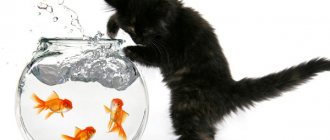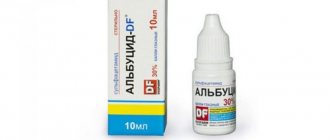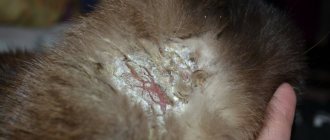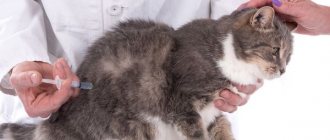Symptoms
The disease in an animal occurs with symptoms that can accompany various diseases, so it is necessary to show the pet to a doctor.
If an animal suffers from vomiting and diarrhea and does not drink water at all, this is an alarming sign.
The inability to defecate indicates insufficient fluid levels in the body.
If the oral mucosa is light in color, the saliva is viscous and does not excrete well, this indicates the presence of pathologies.
With existing infectious diseases and inflammation, the temperature can not only rise, but also fall. A sharp change in body temperature leads to profuse sweating and, accordingly, loss of large amounts of fluid.
So, let's name the main symptoms of the disease:
- dry skin;
- lethargy of the animal;
- sunken eyes;
- lack of normal appetite;
- constipation or diarrhea;
- arrhythmia;
- body temperature atypical for an individual;
- saliva viscosity;
- light shade of gums.
https://youtube.com/watch?v=ZABunrwn5Q8
Constipation in a cat after sterilization: what to do, why it occurs
I always warn my patients: after sterilization, the cat should pee regularly, but at first there may be no stool. If after 3 days the pet does not go to the toilet in a big way, you need to take action.
There are several reasons for intestinal dysfunction. Firstly, this is a long-term starvation diet. Before anesthesia, you can feed the cat 10-12 hours. But if the operation is scheduled for the middle of the day, owners can increase this interval (do not feed the cat in the middle of the night!). Plus, the cat does not receive food for some time after the operation. As a result, she simply has nothing to poop with; it takes time for feces to form.
The second reason is the effect of drugs that are used for anesthesia in cats. Agents for intramuscular anesthesia (Domitor, Rometar, xylazine) not only significantly reduce body temperature in animals, but also affect the motility of the digestive tract. Because of this, intestinal peristalsis on the first day after surgery may be sluggish, and vomiting is possible.
The third reason for constipation after sterilization is simple stress associated with a trip to the clinic, surgery and wearing a blanket. Clothes can irritate your cat and make it difficult for you to get comfortable in the litter box.
If on the 3-4th day after the operation there is no long-awaited pile in the tray, you need to give the cat a mild laxative. It could be:
- A teaspoon of petroleum jelly (about 3 ml)
- A tablespoon of condensed milk half and half with water.
Vaseline oil is given twice a day until the cat has a bowel movement. This is liquid paraffin, the product has no taste or smell, and most importantly, it is not absorbed at all in the digestive tract. It is sold in human pharmacies, no other oil is suitable!
Diagnosis of anemia
Based on its results, the doctor will understand whether hemoglobin is normal and what the erythrocyte sedimentation rate is.
Blood chemistry.
Allows you to determine the level of iron in the blood. A low rate allows one to suspect the presence of a disease.
Hematological examination.
Allows you to determine the number of immature red blood cells.
- Blood clotting testing.
- Urine and stool analysis.
The biomaterial may contain blood and stercobilin. If a viral or infectious nature of the disease is suspected, the doctor will prescribe an additional test.
To obtain a more accurate picture, you may need an ultrasound examination of the kidneys and x-rays to determine tumor processes. A comprehensive diagnostic approach allows you to make a correct diagnosis and develop an effective treatment path.
I would like to draw attention to the fact that it is unacceptable to independently diagnose a cat with anemia and treat it without a doctor’s prescription. In this case, the consequences can be dire
Self-prescribed iron supplements will simply be useless if there is internal bleeding.
Signs of rat poison poisoning
In our country, the most common cause of poisoning of domestic cats are various rodenticides (rat poisons). These products contain different active ingredients, therefore their effect on the animal’s body is different. The most common cause of poisoning is anticoagulant rodenticides. The mechanism of their toxic action lies in the suppression of the production of vitamin K1, which is responsible for normal blood clotting. After ingestion, the animal may feel normal for 3-5 days until vitamin K1 reserves are exhausted. After which the symptoms of rat poisoning begin to appear:
- heavy bleeding even with minor injuries;
- internal bleeding;
- extensive hematomas;
- black chair;
- nosebleeds;
- blood in urine;
- rapid heartbeat;
- shortness of breath;
- lethargy;
- pallor of mucous membranes and skin;
- fainting;
- swelling in the joint area;
- abdominal pain;
- shiver.
The toxicity of rodenticides increases with accumulation if they enter the body several times. A cat can become poisoned by eating bait or poisoned rodents.
Reasons for appearance
Ascites in cats develops against the background of chronic diseases and pathological processes occurring in the animal’s body. The risk group includes individuals with weakened immune systems, permanently living indoors, suffering from:
- cardiovascular diseases;
- renal or liver failure;
- peritonitis (infectious, bacterial or chylous peritonitis leads to high porosity of the vessel walls);
- liver cirrhosis;
- hypoalbuminemia (a decrease in the content of albumin in the blood serum, due to which the walls of blood vessels begin to leak a significant amount of fluid);
- diabetes mellitus
A chain of factors leads to these diseases:
- overweight (obesity);
- imbalance of micro- and macroelements;
- violation of the water-salt balance (excess sodium in the cat’s body caused by eating salty foods, smoked foods, and low-quality dry food);
- excess protein in the body;
- chronic diseases, oncology.
- I’ve gained some weight!..
These factors, in turn, arose and worsened over time due to:
- irresponsible attitude towards the conditions of keeping the animal;
- hereditary diseases or infections.
Diagnostics
In order to find out why a cat’s nose is bleeding, the veterinarian prescribes a comprehensive examination of the animal.
Diagnostic methods:
- Tests are performed: general or biochemical blood test, coagulation test, endoscopy, biopsy, cytology, x-ray examination of the nasal cavity;
- A careful visual examination, examination of the nasal as well as oral tracts, mouth, lower nostrils, throat.
- Urinalysis to assess liver function;
- Serological tests are carried out for the presence of fungal diseases, as well as infections caused by ticks;
- Carrying out computed tomography, magnetic resonance imaging;
- Rhinoscopy;
- Blood pressure measurement;
- Surgery for residual diagnosis.
The need for a specific diagnostic method is determined by the veterinarian depending on the complexity of the symptoms. After the diagnosis is established, treatment is prescribed to eliminate the bleeding, as well as the reasons that caused it.
Negative reasons for discharge
The causes of intrauterine bleeding in cats can be different.:
- Inflammatory diseases, including endometritis, pyometra. The reproductive system of a pet includes the ovaries, uterus, vagina and external genitalia. They are manifested by the animal’s restlessness, the appearance of aggressiveness, and active licking of the external genitalia;
- Damage to the uterus. Accompanied by copious bleeding. There are many blood vessels on the walls of this organ;
- Oncological diseases of cats. Cancer cells suppress the general immune system, including the genitourinary system. Danger is indicated by purulent bloody discharge with an unpleasant odor. They are caused by the growth or destruction of a tumor;
- Decaying placenta. It is possible that after birth, part of the placenta will remain inside. This leads to its decomposition. As a result, blood comes from the vagina. There is a high probability of surgical intervention.
© shutterstock
Types of bleeding in cats
A thorough medical history and physical examination are essential to a correct diagnosis. Your veterinarian may recommend the following tests:
- Abdominal x-ray
- Laparoceptesis - puncture (collection of fluid using a needle and syringe from the abdominal cavity)
- Fluid analysis
- Complete blood count
Depending on your pet's condition and the results of initial tests, additional tests may be needed. These may include:
- Blood chemistry
- Coagulation (blood clotting test)
- Abdominal ultrasound
- Computed tomography (CT) or magnetic resonance imaging (MRI)
Bleeding in cats is divided into:
- Traumatic - occurs due to mechanical damage to blood vessels. The causes of traumatic blood loss are impacts, ruptures, compression, cuts or crushing.
- Non-traumatic - develop as a result of various pathologies of blood vessels or surrounding tissues (for example, with arrosion, wall dissection), as well as malignant formations, purulent inflammation, atherosclerosis and other pathological conditions. Another reason is impaired blood clotting.
Also, depending on the type of vessels that were injured, bleeding can be arterial, capillary, venous and mixed.
In addition, blood loss can be:
- External – resulting from damage to the skin and/or mucous membranes;
- Internal - in this case, blood is poured either into the body cavity (for example, the pleural cavity, cranial cavity, abdominal cavity and others) or into the lumen of a hollow organ (uterus, bladder, stomach, trachea and others).
The last option is the most dangerous in its consequences and often ends in death. Therefore, you should know how internal bleeding in cats manifests itself clinically.
Intestinal bleeding in a cat can usually be suspected if the animal's stool contains bloody streaks or bloody discharge from the anus is observed.
Determining the reason why intestinal bleeding occurred is possible only in a hospital setting, when the doctor has the necessary equipment at hand to examine the animal.
The doctor should stop the bleeding as soon as possible. After making a diagnosis, the doctor begins treatment of the animal.
At the veterinary clinic, specialists will conduct a clinical examination of your cat, during which they may detect anemia in the cat. During bladder catheterization, urine will be collected for laboratory tests. Laboratory analysis includes:
- Urinalysis - determination of the presence of blood and other impurities in the urine.
- Culture of urine on nutrient media will help determine the type of infection and titrate the isolated pathogen for sensitivity to antibiotics.
- For vaginitis, a vaginal smear is taken.
- A general blood test will help determine whether the cat has inflammatory processes.
- Biochemical blood test - determine the functional capacity of the kidneys.
- Coagulogram is a blood test for clotting.
- X-ray of the abdominal organs - to detect stones in the kidneys and ureters.
- X-ray contrast examination - can detect stones, bladder tumors or congenital anomalies (bladder diverticula).
- Ultrasound of the abdominal cavity - will detect the presence of tumors and stones in the kidneys and bladder.
- Histological examination to determine the type of tumor and subsequently prescribe appropriate chemotherapy.
- Cytoscopy is an examination of the bladder and urethra using an endoscope, allowing a veterinarian to examine the inner surface of the urinary and genital organs.
Treatment of hematuria depends on the cause of the hematuria. At home, as first aid, the owner can do the following:
- We provide the cat with complete rest in a warm room and plenty of clean, fresh water.
- For pain relief, give an intramuscular injection of an anesthetic (no-spa, baralgin).
- Solid food is replaced with liquid food.
- Give the cat a decoction of parsley or bearberry root (they have a disinfectant effect).
Once the type of bladder stones is determined, an appropriate diet will be recommended.
If the cat is bleeding, hemostatic drugs are administered.
To relieve pain and spasms during urination - antispasmodic drugs (no-spa, drotavertin).
If the body is dehydrated, infusion therapy will be performed.
In case of poisoning with anticoagulants, vitamin K 1 will be prescribed.
In case of infection of the genitourinary system, a course of treatment with titrated antibiotics will be prescribed.
Causes of blood in cat stool
Let's take a closer look at the most likely reasons why a cat may go to the toilet with blood.
Worm infestation
Roundworms and tapeworms are quite common not only in street cats, but also in domestic cats whose owners neglect preventive treatment. A cat can become infected not only by eating raw meat, but also through contaminated care and interior items (for example, parasite eggs can be brought into the house with shoes). An accurate diagnosis is made only by stool analysis (and often several samples are required), as well as by external symptoms: the cat is losing weight, dull fur, and the stomach may be swollen. Feces can be either normal or liquid, with blood, mucus and sometimes even worms.
Constipation
Constipation as a result of a lack of fiber in the diet is one of the most common manifestations of indigestion, accompanied by blood in the feces of a cat. As a result of overstrain of the rectum and anus, constantly bleeding microtraumas are formed, resulting in blood appearing in the feces. It is worth noting that if there is no stool for more than two days, then the pet must be urgently shown to a veterinarian to rule out the presence of a foreign body or megacolon (pathological enlargement of the colon).
Colitis
Colitis and other chronic inflammatory processes in the stomach and intestines are common causes of blood in a cat's stool. These diseases include food hypersensitivity, bacterial colitis, irritable bowel syndrome and inflammatory bowel disease. With these diseases, the cat usually has bloody diarrhea. These pathologies are quite difficult to diagnose; in addition to blood tests and ultrasound of the abdominal cavity, you may need a trial diet, trial treatment with antibiotics, and even submitting a piece of intestinal tissue for histology.
Traumatic bowel injury
Intestinal injuries, which in mild cases can cause the cat to poop with blood, and in severe cases - the development of peritonitis, occur as a result of eating bones (especially chicken, fish), foreign objects (various toys or threads with a needle, fish hooks) ), as well as as a result of a car injury or a fall from a height. Diagnosis is usually made by performing an x-ray or ultrasound of the abdomen.
Intestinal neoplasms
Intestinal tumors, such as lymphoma, carcinoma, and squamous cell carcinoma, are unfortunately quite common in cats and have a poor prognosis. With these diseases, the cat will have loose stools with blood. The diagnosis is made based on the results of an ultrasound scan of the abdominal cavity, followed by submission of pathological material for histology to confirm the diagnosis, determine the type of tumor and prescribe specific treatment.
Viral infections
Viral diseases that can occur with the presence of blood in a cat’s stool include feline coronavirus infection (feline infectious peritonitis) and feline panleukopenia (feline distemper). The diagnosis is made by donating blood and swabs from the rectum for PCR.
Protozoa infections
The most common protozoa that can cause blood in a cat's stool include giardiasis, trichomoniasis, and cytozoonosis. The diagnosis is made by submitting fresh stool or straight intestinal swabs for PCR diagnostics.
Bleeding disorders
These processes are most often associated with poisoning as a result of a cat eating anticoagulant drugs, which are often used as poison for mice. Symptoms of the disease are usually striking - sudden lethargy, apathy, refusal to eat, but the first sign may be that the cat is pooping blood.
Subscribe to the newsletter and get a discount at the pet store “Lubimchik”
Thanks for subscribing!
Internal bleeding in cats
Bleeding is the escape of blood from a blood vessel.
- Types of bleeding
- Causes
- Danger of bleeding
- Diagnostics
- Treatment
Types of bleeding
There are external, internal, arterial, venous and capillary bleeding. During arterial bleeding, blood flows out in a strong intermittent stream, its color is bright red.
With venous bleeding, the stream is weaker, without pulsation, and the color of the blood is dark red. Capillary bleeding is characterized by the appearance of drops of blood (for example, with skin abrasions).
Unlike external bleeding, internal bleeding is the most dangerous for the body due to late detection and difficulties in stopping it.
Internal bleeding in cats can be obvious (intestinal, pulmonary, gastric, uterine, etc.):
- Nosebleeds (epistaxis)
- Passage of altered blood in the stool, stools streaked with blood (tarry stools) (melena),
- Hemoptysis, when coughing, scarlet foamy blood (hemoptoea) is released,
- Vomiting blood (vomiting "coffee grounds") (hematemesis),
- Bloody discharge from the loop,
- Discharge of blood in the urine, blood in the urine, red urine (hematuria).
Internal bleeding can also be hidden (bleeding into closed body cavities occurs mainly as a result of damage to internal organs and blood is not released outside).
Such bleeding can be suspected only by changes in the general condition. Lethargy, apathy, shortness of breath, pallor of the mucous membranes, and a rapid increase in abdominal volume may be observed.
Causes
- Neoplasms – tumors can rupture and cause bleeding,
- Injuries – high-altitude injury (fall from a balcony), car injury and many others,
- Coagulopathies - if blood clotting is impaired (often due to poisoning).
Danger of bleeding
With blood loss, the volume of circulating blood decreases, blood pressure drops, the number of red and white blood cells decreases, which leads to a lack of oxygen in the tissues, a decrease in the protective properties of the blood and serious consequences for the body as a whole.
The consequences of bleeding are ambiguous and depend on the damaged vessel (artery, vein, capillary), the rate of bleeding and the amount of blood lost, the condition of the body, etc. Severe disturbances in the body are noted when there is a loss of 30% or more of circulating blood.
Loss of 50-60% of blood sharply reduces blood pressure, oxygen supply and death occurs.
With prolonged (chronic) but minor blood loss, the number of red blood cells and hemoglobin decreases, oxygen starvation occurs, vital activity decreases, and general anemia develops with serious consequences for the body.
Diagnostics
If your cat shows symptoms of internal bleeding, contact your veterinarian immediately. At your appointment, your veterinarian may conduct the following diagnostic tests:
- Anamnesis collection (you will have to tell the whole medical history, any details are very important),
- Physical examination of the animal,
- X-ray examination - allows you to detect the presence of free fluid, neoplasms,
- They may perform laparocentesis (drawing fluid from the abdominal cavity with a syringe), fluid analysis,
- Blood tests (Clinical analysis - allows you to see the presence of anemia, Biochemical analysis - see if there is damage to internal organs, Coagulogram - can show a blood clotting disorder),
- Ultrasound – detects the presence of neoplasms.
- CT and MRI will be able to show what will not be visible on X-ray and ultrasound.
Treatment
Treatment of internal bleeding in a cat depends on the severity and clinical condition of the animal's condition, the cause of the disease:
- Pain relief – will calm and improve the condition of the animal,
- Intravenous infusion will help maintain blood pressure, improve the perfusion of organs and tissues,
- Blood transfusion – for severe anemia,
- Compressive bandages - will slow down or stop bleeding,
- Use of Vitamin K – in case of poisoning with anticoagulants, rat poison, coagulopathies,
- Emergency exploratory surgery
It is very important to consult a veterinarian in time, establish the cause of internal bleeding, and provide emergency assistance to your pet. Your pet's life is in your hands! The article was prepared by Andreeva T.V.,
The article was prepared by Andreeva T.V.,
veterinary doctor-therapist "MEDVET" 2021 SEC "MEDVET"
Diagnostic methods
If the doctor suspects such a condition in a fluffy dog, then he must undergo an ultrasound of the organs located in the peritoneum.
As soon as your cat develops symptoms of internal bleeding, you should immediately contact a veterinary clinic, where the pet will be examined and a comprehensive examination will be prescribed to determine the source of the problem and assess its severity. In case of violation, the following procedures must be followed:
- X-rays of the peritoneum;
- puncture of the abdomen using a needle or syringe and laboratory examination of the resulting sample;
- detailed blood test;
- coagulogram;
- ultrasound diagnostics of the abdominal organs;
- CT and MRI.
Veterinarians warn that a comprehensive examination is carried out only after internal bleeding has stopped and the cat’s condition has stabilized.
Can you help your pet yourself?
When the first signs of blood loss appear in a cat, measures must be taken to stop it.
Stopping bleeding can be temporary or permanent.
By using a temporary stop, you can prevent critical blood loss and gain time for a final stop. Methods for temporarily stopping external bleeding include: applying a pressure bandage or tourniquet, pressing the artery with a finger.
The bandage can be used for capillary types of bleeding, minor venous and arterial. A napkin is placed on the site of the injury, cotton wool rolled into a tight ball is placed on top, and then bandaged tightly. A pressure bandage is the most popular and effective method of temporarily stopping bleeding in pets.
When you have temporarily stopped the bleeding, you need to immediately go to the veterinarian or call him to your home. If you suspect internal bleeding, then you don’t need to do anything yourself so as not to worsen the existing situation. Immediately show your pet to a specialist, in this case, with moderate injuries, there is a chance that the fluffy one can be cured and returned to his previous healthy life.
Any bleeding in a pet causes strong emotions in owners: from anxiety to panic. Nothing human is alien to cats, and therefore they are susceptible to nosebleeds no less than people. Sometimes this is a single manifestation of some temporary disorder, sometimes it is a signal of a serious illness.
Let's figure out why a cat's nose bleeds when sneezing, and how you can help it.
When is it time to go to the vet?
The main rule of any cat owner: no panic! Anything can happen in a cat’s life, and you shouldn’t rush around hysterically when you notice a drop of blood on your pet’s paw. But there are things that definitely require a visit to the veterinarian:
- the animal began to bleed blood from its natural orifices;
- The cat's feces are dark red;
- the pet vomits blood;
- blood is visible in the animal's urine;
- one or both eyes of the pet are red;
- The cat has hematomas (voluminous, elastic swelling) under the skin on the paws (leg, thigh, shoulder), on the outer ear, on the oral mucosa or skin.
In these cases, there is no point in delaying a trip to the veterinary clinic. However, before meeting with a doctor, there are some things you can do for your pet yourself:
- minimize stress in the animal by providing it with warmth and peace;
- move the cat very carefully (especially if there is a suspicion of injury);
- apply a cold compress to the suspected area of injury;
- Do not give your pet water, food, medication, or try to administer an enema.
And most importantly, remember: you cannot cope with internal bleeding on your own! In these cases, all hope lies with the veterinarian.
At the slightest suspicion of internal bleeding in a cat, a visit to the veterinarian is inevitable.
How can the doctor help?
The first task of a specialist is to conduct a competent diagnosis. After all, for example, the visible manifestations of gastric and intestinal bleeding are very similar, and in really serious cases, the life of your pet depends on the speed of making a diagnosis and taking adequate measures.
Typically diagnosis includes the following steps:
- taking an anamnesis (you will have to tell the whole medical history, any details are very important);
- physical examination of the animal;
- X-ray of the abdominal cavity (allows us to detect the presence of free fluid in the abdominal cavity, as well as massive formations such as tumors and hematomas);
- puncture of the abdomen using a needle and syringe (to obtain a sample of fluid for analysis) and analysis of the resulting fluid;
- blood tests (clinical analysis shows the presence of anemia, biochemical analysis determines the presence of damage to internal organs, coagulogram shows a blood clotting disorder);
- ultrasound examination of the abdominal cavity (allows us to detect the presence of tumors in the abdominal cavity);
- CT or MRI (allows you to visualize neoplasms that are inaccessible to ultrasound).
The physical (primary) examination of the animal consists of mandatory steps, performed in any order. This is mainly a visual examination and palpation (palpation), in which the specialist uses his senses and uses vision, touch, smell and hearing.
Immediately after diagnosis, the veterinarian prescribes treatment, which directly depends on the cause of the bleeding and the general condition of the animal. The most typical stages of such treatment are the following:
- abdominal puncture (pumping out excess fluid that interferes with normal breathing);
- intravenous administration of saline and plasma preparations to maintain the required blood pressure;
- blood transfusion (blood transfusion) with significant blood loss;
- an increase in intra-abdominal pressure to help stop bleeding (using compression bandages);
- oxygen therapy;
- anesthesia;
- administration of vitamin K (for coagulopathy);
- emergency surgery if treatment does not give results (does not stop bleeding) or in cases of neoplasms.
The result of the operation can be both the actual stopping of internal bleeding and the removal of an organ damaged by injury or an oncological process that caused blood loss. The postoperative period takes place in a hospital setting, where the animal receives the necessary antibacterial therapy and transfusions of plasma and blood preparations.
Treatment
A disease in which a cat vomits blood will not cure on its own. A visit to the veterinary clinic is inevitable. But the owner does not always have the opportunity to do this immediately. This condition cannot be ignored, otherwise death is possible.
What can an owner do if a cat is vomiting blood?
With such a pathology, the owner is severely limited in the ability to provide first aid. He can only put the cat on a starvation diet for 1-2 days and ensure complete rest. Clean drinking water during this period should be available and in abundance.
Attempts to feed the cat will only worsen its situation, since food masses further irritate the damaged gastrointestinal mucosa.
What can a doctor prescribe if a cat is vomiting?
After confirming the diagnosis, the veterinarian prescribes treatment. Usually this is a detailed diagram of the use of procedures and medications under the supervision of a specialist.
If the cause of vomiting with blood in a cat is minor damage to the blood capillaries of the mucous membranes of the gastrointestinal tract, then conservative treatment is prescribed (diet, increased consumption of clean drinking water, mild medications to stabilize blood clotting, restoratives, vitamins, antibiotics - if necessary, at the discretion of the doctor) . In case of poisoning with anticoagulant poisons, cats are prescribed Vicasol intramuscularly (vitamin K), starting with a loading dose and gradually reducing the volume of the drug. Symptomatic therapy is also carried out (adsorbents, blood replacement droppers to restore blood volume and avoid dehydration). After eliminating the main symptoms, restorative therapy is carried out. In general, the prognosis is unfavorable. Gastrointestinal neoplasms in all animal species can only be cured by surgery. A distinctive feature of neoplasms in the gastrointestinal tract is their long development. This allows them to be successfully removed. For severe forms of inflammation in the large intestine, cats are treated with immunosuppressive drugs (to suppress the activity of the immune system). But diagnosed lymphoma is treated in a comprehensive manner - after surgical removal, chemotherapy is prescribed. If foreign bodies are detected in the gastrointestinal tract or respiratory organs, surgical intervention is performed (abdominal or laparoscopic). After surgical treatment, proper postoperative care is required (elimination of physical activity, diet). Treatment of bleeding in the lungs in cats involves emergency hospitalization under the supervision of a veterinarian. Antitussive drugs are used (to reduce the mechanical effect on lung tissue), coagulants to increase blood viscosity and coagulability, as well as restorative drugs. If necessary, blood replacement therapy is carried out. When vomiting during infectious diseases, cats are, if possible, given specific passive antibodies. The rest of the treatment is reduced to symptomatic therapy, the use of painkillers, restoratives, immunostimulating, vitamin preparations
An important place in such treatment is occupied by the period of rehabilitation (recovery) after an illness.
Care and recovery period
When internal bleeding occurs, the pet needs to be given maximum attention, since this is a lot of stress for the animal. If there is a violation, it is important to place the cat in a warm environment where he will be comfortable and safe. If the blood loss is associated with a fracture, then immobilize the cat’s injured limb and quickly deliver it to a veterinary clinic. Equally important is post-operative care to help your cat recover faster. To do this, the pet is given a clean and warm place, is not allowed to suffer from hypothermia and is on a diet, especially if the development of internal bleeding is affected by gastrointestinal pathologies.
Features of internal bleeding
Internal bleeding is the release of blood from damaged vessels into the body: into the abdominal or pleural cavity, into the space between muscles, into subcutaneous tissue, as well as inside hollow organs, for example, into the bladder, trachea or stomach.
The degree of danger to the pet's life depends on the rate of bleeding. With chronic, relatively small blood losses, oxygen starvation of the body tissues begins, anemia develops, metabolic processes are disrupted, which entails cell death. The animal’s activity decreases, the quality of its fur deteriorates, and the pet loses weight to the point of anorexia. In rare cases, lethargy develops.
Bleeding may stop due to the formation of clots that block the breakthrough, and then resume again due to their displacement. In this case, periods of weakness in the animal will alternate with normal health.
A blood clot can block a damaged vessel, but this improvement will only be temporary
With severe internal bleeding, the cat can die both due to a drop in pressure and oxygen starvation, and due to blood squeezing vital organs, such as the heart or brain. Without qualified assistance, death in this case occurs within a few hours or minutes, depending on the type of injury.
Acquired coagulation factor disorders in cats.
Most clotting proteins are produced by the liver. Therefore, liver disease can cause a decrease in the amount of proteins produced, in particular factors VII, IX, X and XI.
Cat poisoned by rat poison
, may also have problems with blood clotting, as the venom reduces the production of essential proteins. Affected cats may develop blood clots and bruises in many tissues. If you suspect that your cat may have eaten rat or mouse poison, you should immediately consult a doctor, as this is very life-threatening.
Disseminated intravascular coagulation (DIC) is a disease in which small clots form in the blood, blocking small vessels and destroying platelets and clotting factor proteins needed to stop bleeding. The disease usually develops after some precipitating event, such as severe infections, heat stroke, burns, tumors, or serious trauma. In many cases, there are signs of uncontrolled bleeding and failure to form blood clots normally. Death can occur as a result of excessive blood clots and impaired blood circulation, which leads to insufficiency in one or more of the cat's organs. If the cat manages to survive the crisis, DIC may become chronic. For treatment, the veterinarian tries to identify and eliminate the primary disease
To restore normal blood circulation, it is very important to administer intravenous medications on time. DIC is a very dangerous disease, often fatal for cats.
Pulmonary edema in a cat after sterilization
Long gone are the days when pets were anesthetized “by eye,” and the owners begged the doctor “not to overdo it.” Now veterinary clinics have modern and safe means of anesthesia. Large clinics use inhalation anesthesia and epidural anesthesia. Despite this, general anesthesia can cause dangerous complications in cats after sterilization.
If your cat has problems with the heart muscle (hypertrophic cardiomyopathy, congenital defects), pulmonary edema or thromboembolism may develop after surgery. Both complications can lead to the death of the animal, even if the owner notices something is wrong in a timely manner and consults a doctor.
As a doctor, I recommend doing a cardiac ECHO (ultrasound) before surgery. So we can be calm or, on the contrary, look for options for anesthesia and medicinal support. In practice, owners most often refuse the study to cut costs. With the words “Yes, this is a cat, what will happen to her.” To be fair, I note that most cats do tolerate anesthesia well. But there are breeds in which HCM (hypertrophic cardiomyopathy) occurs much more often than in outbred cats. Here are some popular cats that are at risk:
- Maine Coons;
- Sphinxes;
- British cats;
- Scottish cats.
Scottish Fold ECHO of the heart is a must
Owners should monitor their cat for at least two weeks after sterilization. The pet should eat, drink, and play as usual within 24 hours. If a cat refuses to eat, lies in one place, breathes with its mouth open like a dog, you should immediately contact a well-equipped clinic for diagnosis.
Overt and hidden internal bleeding
Although internal bleeding itself cannot be seen with the naked eye, some types of it are still characterized by certain external manifestations. This type of bleeding is called overt internal bleeding.
Table: external signs of obvious internal bleeding
| Type of obvious internal bleeding | External signs |
| Bleeding in the esophagus | Vomiting blood (blood in the vomit is scarlet) |
| Stomach bleeding | Coagulated dark red or brown blood (“coffee grounds”) in vomit |
| Intestinal bleeding | Vomiting "coffee grounds" (for bleeding in the small intestine) and/or stools that are dark bloody or resemble "coffee grounds" (for bleeding in the lower intestine) |
| Pulmonary hemorrhage | Cough with frothy, bloody sputum |
| Uterine bleeding | Bloody discharge from the loop |
| Kidney bleeding | Blood in any urine |
Any caring owner will definitely pay attention to such alarming manifestations, which means that the animal’s chances of not bleeding to death are quite high. The situation is much worse with so-called hidden internal bleeding
Hidden internal bleeding
Hidden internal bleeding does not have any immediate manifestations visible to the eye. This is because they occur inside body cavities (such as the abdominal cavity) or organs (such as the spleen) that have no communication with the outside environment. However, such bleeding has certain indirect signs:
- dyspnea;
- pallor of the mucous membranes;
- sudden fatigue;
- lack of appetite;
- weight loss;
- apathy and drowsiness;
- rapidly increasing abdominal volume;
- bruises under the skin.
Pale mucous membranes of the animal (best seen on the inside of the lips and gums) may be a sign of hidden internal bleeding
And the owner must be truly attentive to his pet in order to recognize warning signs in time and help the animal save its life.
Dangerous diseases
Dangerous pathologies that threaten the life of an animal associated with the genital organs of cats are characterized by the presence of various symptoms, including the appearance of discharge mixed with blood. The most common causes of bleeding are pyometra and endometritis. Pyometra is diagnosed in cats with elevated levels of progesterone in the bloodstream.
The risk of developing pyometra is higher in cats that have never given birth, as well as in cats that are constantly receiving drugs to suppress sexual estrus. When pyometra develops in an animal, signs such as depression in the general condition of the animal, refusal of food, pain are noted, and pus mixed with blood flows from the area of the loop.
It is worth noting that there are two types of pyometra - closed and open. Streaks will be noticeable from the vagina only in the open form of the disease, since the cervix, which does not tightly close the entrance, will allow discharge to pass through. This form of the disease is considered less dangerous, since the purulent contents in the uterine cavity are gradually released.
The closed form of pyometra threatens the animal with death if diagnosis and surgery are not performed in a timely manner. Pus with blood accumulated inside breaks through the walls and enters the abdominal cavity, causing sepsis and other life-threatening conditions of the animal.
Endometritis is an inflammatory process on the uterine mucosa that develops under the influence of infectious agents. The cause of the development of endometritis may be hormonal imbalances as a result of taking drugs that suppress sexual desire, an unbalanced diet, difficult childbirth, or violation of sanitary standards for keeping the animal.
Inflammation of the uterine mucosa occurs in acute or chronic form. With a sluggish form of endometritis, the cat’s discharge is barely noticeable, due to which the blood released from the vagina in cats is practically invisible.
The particular danger of this type of disease is its rapid transition to a purulent form. In the acute form of endometritis, the discharge is abundant and it is quite difficult not to notice it.
Uterine bleeding is a dangerous pathology characterized by a hidden course and gradually increasing symptoms. It is quite difficult to notice that a cat is bleeding from the vagina, since most bleeding in the internal organs is not characterized by outward flow. The development of bleeding in the uterine cavity can occur from several days to several weeks, therefore, if vomiting, upset stool in a cat, or blood fractions in the excreted portion of urine occur, this is a reason to urgently consult a veterinarian.
Classification of abdominal injuries in cats
Cats suffer from abdominal injuries such as:
- Penetrating wounds. Characterized by rupture of the peritoneal wall and adjacent internal organs. Bleeding begins and peritonitis quickly develops.
- Injury. It manifests itself as swelling, edema, hematoma, and soreness of muscle tissue. In this case, there is always a risk of organ rupture, which invariably leads to internal bleeding.
- Hemorrhage in the retroperitoneal space. Occurs as a result of closed injury to the kidney, liver, intestines, and stomach.
An open abdominal injury can be detected visually even by the owner of the animal. But bruises and hemorrhages can not always be recognized, especially if the cat is in a state of shock.
Hernia after sterilization of a cat
In my practice, I have never seen a hernia occur after sterilization of a cat. This is due to the short length of the incision required to remove the uterus and ovaries. However, such a complication does occur, so I will mention it. Sterilizing a cat is a abdominal operation. The doctor must carefully stitch up the abdominal incision. A hernia occurs when the sutures fail.
A hernia looks like a protrusion under the skin in the suture area and can be of different sizes. The omentum (internal fat on ligaments) or intestinal loops fall out through a hole in the abdominal wall. The hernia definitely requires repeated surgical intervention. The operation should not be delayed to avoid the formation of adhesions or strangulation of the hernia.
Young cats will have a very small incision before their first heat.
What to do if your cat has a tumor?
Mammary gland neoplasms are a widespread pathology among furry beauties. More often, the disease is detected in older cats after 6 - 7 years. For various reasons (late diagnosis, contraindications to surgery, choice of a conservative treatment method), the owner is faced with the fact that the cat has a tumor.
Why does this happen and how to act in such a situation? Veterinary experts recommend taking your pet to a specialized facility as quickly as possible. However, if urgent hospitalization is not possible, the owner needs to know how to provide first aid to the animal themselves.
Preventive actions
To prevent anemia in a pet, the owner must follow a number of simple rules:
You can provide your animal with complete and balanced nutrition and get specific recommendations regarding the diet of a particular breed from your veterinarian. A cat's diet should be rich in protein, so beef, chicken and turkey are a must. Also pamper your pet with offal twice a week. The liver is especially useful. Fermented milk products will ensure proper functioning of the intestines, and introduce vegetables as a source of iron, copper and vitamins. Give your pet the opportunity to splash out its energy; do not limit its activity. Timely implementation of anthelmintic measures
Typically, anti-parasite medications need to be given to your cat once a quarter. Vaccinating your animal will help prevent diseases that cause anemia. Avoid contact between your pet and its stray relatives. Pay special attention to safety. All toxic substances and medications must be kept out of reach of the animal
When treating a living space with insecticides, it is necessary to exclude the cat from being there until the time recommended by experts. If signs of illness are detected, immediately show the cat to a doctor. It is more effective to treat any disease in the first stages. Therefore, you should not delay going to the veterinarian. The ideal option would be systematic preventive examinations by a specialist.
Forecast
Anemia in cats is a serious disease that, if ignored, can be fatal. Therefore, when the first signs appear, visit your veterinarian as soon as possible. The earlier the disease is diagnosed, the better the prognosis.
It is important to remember that the correct diagnosis can be made by a doctor when conducting appropriate laboratory tests and studies. Acquired anemia responds well to adequate treatment, so strictly follow all recommendations received
To avoid relapse, do not neglect preventive measures. If anemia is caused by the presence of an oncological process, then in this case the prognosis will depend on its severity. A similar situation will occur with an autoimmune disease.
Is it possible to cure the disease?
Dropsy in a cat is not a death sentence. If you seek help from a specialist in time and follow all his recommendations, then ascites in cats can be cured without serious consequences for its body. But if you postpone a visit to the veterinarian, the result can be very sad.
Note! The animal accumulates more than 2 liters of water per day, which will put pressure on the internal organs and lead to disruption of their function, which can be fatal.
Treatment at home
Of course, it will not be possible to independently determine the disease and begin reasonable treatment. There is no point in risking the cat’s life; it should be taken immediately to a veterinarian, who will determine the true disease and prescribe reasonable treatment. The specialist will explain how and with what to treat the mustachioed man, and will also prescribe the necessary medications that will help him get back on his feet. Only through a timely visit to the doctor can ascites be cured.
Drug therapy for underlying diseases and ascites
When a cat has dropsy, it is first necessary to eliminate the disease itself, which led to the appearance of ascites. It is imperative to relieve pain symptoms and strengthen the immune system.
Important! Diuretics become the first aid in such a difficult situation, and then, depending on the disease, other drugs are prescribed.
Cat treatment
| Medicines | What is it prescribed for? |
| Furosemide, Temisal | They have a diuretic effect. Prescribed for heart and kidney failure. |
| Olitorizide, strophanthin, digitoxin, cardiovalene | Used to stabilize the cardiovascular system. |
| Cephalosporins | These antibiotics are prescribed if there is an infection in the animal's body. |
| Intravenous 10% solutions of calcium chloride | Used to strengthen blood vessels and reduce their permeability. |
| Foxglove tincture | Regulates the functioning of the heart muscle. |
| Lily of the valley tincture | Has a cardiac effect. |
| Gamavit, maxidin, interferon | Give to the cat to strengthen the immune system |
Folk remedies
Traditional methods of treatment cannot completely cope with the disease, but they are quite capable of slightly alleviating the suffering of a mustachioed person for the first time. The most popular among them include:
- birch tea. The leaves are brewed in a ratio of 1:10. Add 2 g of soda per 1 glass. Infuse this decoction for 6 hours, then filter and give to the cat. Because of the soda, it may have an unpleasant aftertaste, but you need to pour 1 teaspoon into your pet. The procedure is repeated morning and evening. With the help of this decoction it will be possible to remove the stomach, but it will not be possible to cure the disease itself that led to cat ascites;
- herbal mixture of gorse, princeling, bedstraw and birch buds. For half a liter use 2 tbsp. spoons of herbs. The broth is infused in a water bath for 30 minutes. The pet is given 1 teaspoon 5-6 times a day;
- herbal collection of omentum, angelica, cinquefoil and calamus root. They are also taken in the proportion of 2 tbsp. spoons per 500 ml. The broth must be boiled for 20 minutes. You can give it to your cat five times a day.
Medical nutrition, diet
To make the cat’s recovery process faster, the animal needs to be provided with proper nutrition:
- salty foods are removed from the diet;
- it is necessary that the diet be rich in minerals and carbohydrates;
- fluid intake is significantly limited;
- Products should include low-fat milk, meat, sea fish and cottage cheese.
Eating
Pumping out liquid
Veterinarians perform a puncture to drain fluid from the abdominal cavity. Thus, the contents must be pumped out at least 2 times every 7 days. Fluid removal is compensated with albumin solution.
Note! Dropsy of the abdominal cavity is not hydrocephalus, in which the cat will only have to be euthanized. If the pet has any pathological disease or a weakened immune system, then dropsy will develop rapidly, but with a lightning-fast reaction from the owner to the problem, the animal can be cured. The sooner a doctor examines him, the greater the chance of a successful recovery.
What kind of bleeding can there be?
Although the cause of blood loss is always a violation of the integrity of the vessel wall, the bleeding itself can be very different.
Table: classification of bleeding
| Classification sign | Types of bleeding |
| Type of damaged vessel |
|
| Time of bleeding |
|
| Direction of blood flow |
|
With external bleeding, blood flows freely outward
At the same time, no matter how the blood loss occurs (drop by drop, in a thin stream or in a pulsating fountain), external bleeding is almost always clearly visible, while internal bleeding is never visible. And this makes internal bleeding especially dangerous.











